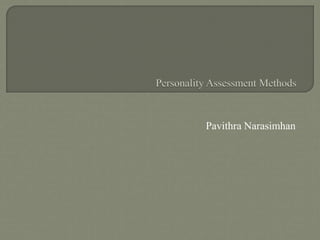
Personality Assessment.ppt
- 2. Personality tests help us understand our distinct character and features. They're an assessment method that measures all of our unique traits, such as: Behaviours: the way we conduct ourselves and our interpersonal relations Emotions: our instinctive and intuitive feelings Attitudes: the way we think or feel about something Motivations: our reasons for behaving a particular way Values: our unique principles or standards of behaviour.
- 3. Self-discovery: getting insight into who we are Research contribution: helping psychologist identify patterns between our personality types and behaviours Self-development: bettering ourselves by identifying areas of development Career and academic counselling: identifying potential career paths and informing our decision-making Job testing: testing for a new job position. Diagnosis: identifying potential personality disorders by analysing our behaviours and mental functions.
- 4. Projective tests Behavioural tests Objective test of personality (multiple choice, rating)? Items in this format can be answered, scored, analyzed, and interpreted quickly.
- 5. These techniques are assumed to reveal those central aspects of personality that lie in the unconscious mind of an individual. Unconscious motivations, hidden desires, inner fears and complexes are presumed to be elicited by their unstructured nature that affect the client’s conscious behaviour.
- 6. i) Constructive: It includes all those tests and situations where the construction of some specific task is to be done by the examinee. The subject needs to frame a structure upon the situation presented by the examiner, and be asked to draw a human figure allowing the person to freely express the examiner’s inclination. (TAT) ii) Constitutive: This category includes those tests which require the examinee to constitute structures upon some given unstructured materials, as for example, The Rorschach Ink Blot technique. iii) Interpretative: It includes those test situations where the examinee has to add a detailed meaning to the given situation. For example, Sentence completion test and the Word Association Test. iv) Refractive: This category includes all those techniques through which the examinee gets the opportunity to depict his personality in the form of drawing, painting etc. Frank cited that graphology is the best example of this category.
- 10. These techniques are assumed to reveal those central aspects of personality that lie in the unconscious mind of an individual. Unconscious motivations, hidden desires, inner fears and complexes are presumed to be elicited by their unstructured nature that affect the client’s conscious behaviour.
- 11. Behaviorists assume that personality is a composite set of learned responses to stimuli in the environment. Methods used are - interviews, direct supervision, and self-observation. One of the methods is direct observation, that requires the psychologist to observe the client while engaged in ordinary, daily-routine behaviour, at home, school, workplace or any other natural setting. Among other methods often used by behavioural therapists are rating scales and frequency counts. In a rating scale, either the psychologist or the client assigns a numeric rating or some specific behaviour. On the other hand, in a frequency count, the frequency of certain behaviours in a specified time limit is counted. Both rating scales and frequency counts are being used by educators in the diagnosis of various behavioural problems like attention deficit disorder etc.
- 12. A structured interview is a quantitative research method where the interviewer a set of prepared closed-ended questions in the form of an interview schedule, which he/she reads out exactly as worded. Interviews schedules have a standardized format which means the same questions are asked to each interviewee in the same order
- 13. The interviewer asks open-ended questions based on a specific research topic, and will try to let the interview flow like a natural conversation. The interviewer modifies his or her questions to suit the candidate's specific experiences. Unstructured interviews are sometimes referred to as ‘discovery interviews’ and are more like a ‘guided conservation’ than a strict structured interview. They are sometimes called informal interviews.
- 14. The Production of Figure Drawings • Very often for children who have limited verbal skills. • Figure-drawing tests: Multi-dimensional? Affected by drawing skills Projective Methods in Perspective • Assumptions: Projective hypothesis • Situational variables • Psychometric considerations
- 15. Mary is 35-year old. She is attractive and has a doctorate in nuclear physics from MIT. Her career is considered very successful because by the age of 30 she became a professor. But she has problems in relationship. She tried e-harmony.com and were approached by several men. But none of them continued dating with her after three meetings. How can you help her? What personality assessment approach will you use?
- 16. Guess the next ?
- 17. Approaches to Behavioral Assessment • Behavioral observation and rating scales • Situational performance measures • Role play • Psychophysiological methods • Unobtrusive measures e.g. Website traffic log Advantages: • provide behavioral baseline data. • provide behavioral strengths and weaknesses across a variety of situations and environmental conditions.
- 18. Tell a story by looking at a picture. You may expose your conscious or unconscious ideas through your language usage.
- 19. The woman in the picture is a female scientist. She is brilliant, but she is under the supervision of a male scientist. The man is not as good as the woman, but he is the boss. He will take the findings as his own and claim the credit. It is unfair.
- 20. Can you a story based on this picture?